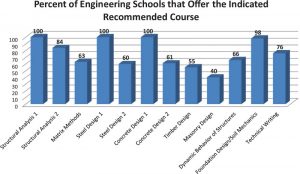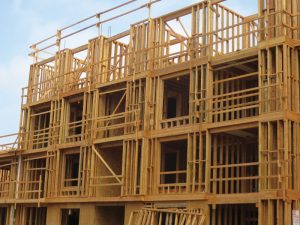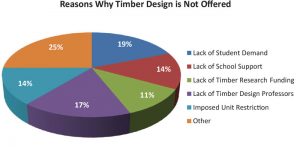Timber is one of the most widely used construction materials in the U.S., especially for low- to mid-rise residential structures. It is also one of the most sustainable materials available. The life cycle of the product involves the sequestration (the physical storage) of carbon, the production of oxygen, and the reduction of energy consumed in creating manufactured products. Even considering these significant benefits and extensive use, surveys conducted by the National Council of Structural Engineers Associations (NCSEA) seem to indicate that many structural engineers graduating from accredited university programs have, in general, not been provided with even a basic understanding of timber engineering.
In a 2004 article, Wood Use in Nonresidential Buildings: Opportunities and Barriers, most designers surveyed had learned little or nothing about wood in school, and many felt the lack of post-professional education was also an issue. The most recent NCSEA Basic Education Committee national survey of engineering schools showed that only fifty-five percent (55%) of institutions offer courses that teach the fundamentals of timber engineering to either their undergraduate or graduate students. Importantly, most of these schools do not actually require their students to take a timber course to graduate.
In years past, this dearth of knowledge prompted some response from industry organizations. In 2007, the Wood Products Council launched the WoodWorks program which provides free project assistance, continuing education, and resources related to the design of non-residential and multi-family wood buildings. WoodWorks partnered with the California State Polytechnic University Pomona in 2008 to create the Wood Education Institute (WEI) program, which was a virtual learning model intended to assist in offering wood education for undergraduate, graduate, and continuing education programs nationwide. However, due to a lack of financial support, WEI is no longer active.
Additionally, the American Wood Council (AWC) provides continuing education on building codes and the organization’s standards to design professionals, mostly through in-person training and free web-based learning. And, although AWC resources for educators include free AWC standards and students receive discounts on AWC standards used in timber engineering courses, there is still a void that needs to be filled for almost half of universities that have an engineering program.
Generally, educators recognize the need for timber programs but are under pressure to move students through the program as quickly as possible and to do so in a way that controls tuition costs and minimizes required resources. This has led to working toward a split-semester course in both timber and masonry. The objective is to provide basic knowledge that will allow the student to either self-teach to a greater concentration in either topic or to recognize that greater academic concentration is required.
Currently, the NCSEA and AWC together are devising new ways to address this issue. By working with universities, structural engineering organizations, and trade organizations, the goal is to demonstrate the need for students to have quality timber engineering education. Work is also underway to identify methodologies to effectively offer and teach timber engineering nationwide.
Some initiatives include:
- Provide students a resource for locating schools and universities that can satisfy timber engineering requirements,
- Work with the NCSEA Structural Engineers Certification Board (SECB) to encourage those engineers seeking certification to have timber engineering in their background and to require students seeking SECB Education Certification to have some timber education,
- Provide further evidence of the growing need for timber education as has been revealed in a recent Structural Engineering Practitioner survey that showed that 95% of respondents felt their new hires should have timber engineering instruction, and
- Work with practitioners and educators to determine the content of a rigorous timber engineering program, and expected outcomes, via a Timber Symposium held at the ASCE/SEI Structures Congress in April, 2017.
This last initiative is a unique partnership between ASCE/SEI Wood Education Committee, NCSEA Basic Education Committee, and AWC, with an ultimate goal to develop a strategic plan for getting timber engineering courses into universities.
Although these initiatives are ongoing, some wood industry educational efforts have continued to target only design professionals. However, the best opportunity to engage engineers is still at the collegiate level. Manufactured timber processes have continued to get better every year and yield some amazing results. The advent and use of cross laminated timber and mass timber construction are just an example of how far timber construction has evolved. Unless a strong effort is put forth now to create comprehensive timber engineering programs at a majority of universities with engineering programs, the profession will continue to fall behind in having young engineers who can effectively design with timber. This would only hurt the entire AEC industry.▪
The article was based, with permission, on an extended article written for the World Conference of Timber Engineering (2016). The original article is credited as follows: Barnes, C.; Kam-Biron, M.; Okoye, U.; Perkins, B.: Timber engineering education for structural engineers, CD-ROM; Proceedings of the World Conference on Timber Engineering (WCTE 2016), August 22-25, 2016, Vienna, Austria, Eds.: J Eberhardsteiner, W. Winter, A. Fadai, M. Pöll, Publisher: Vienna University of Technology, Austria, ISBN: 978-3-903039-00-1.


